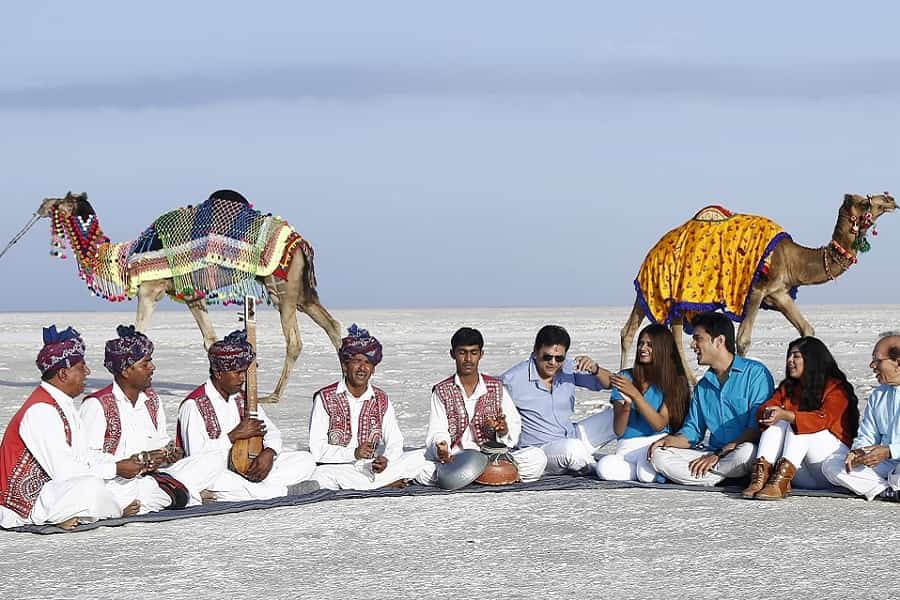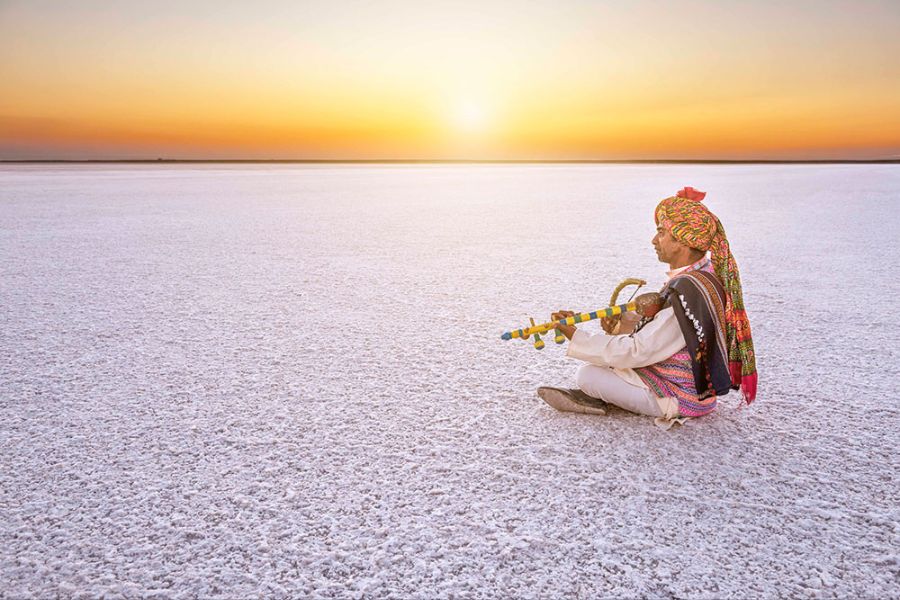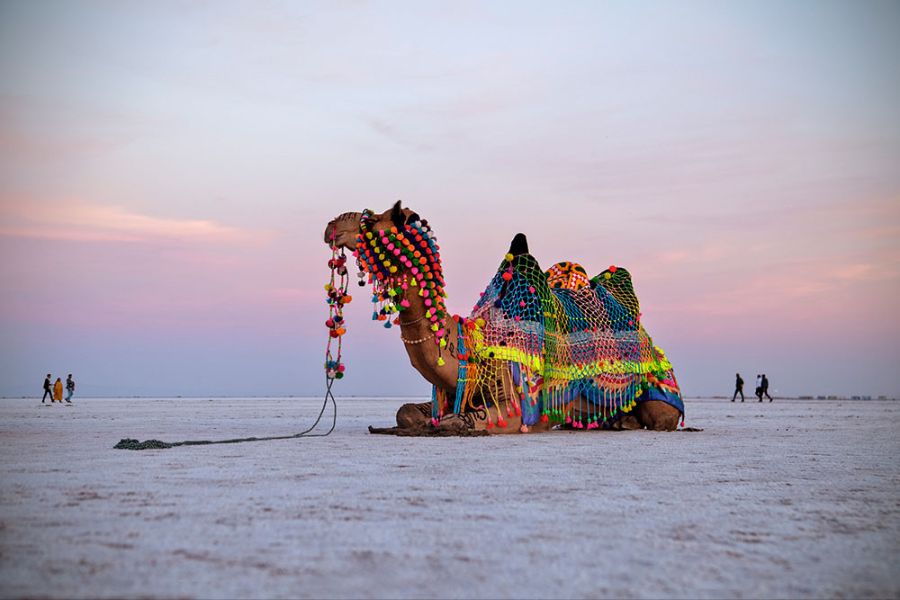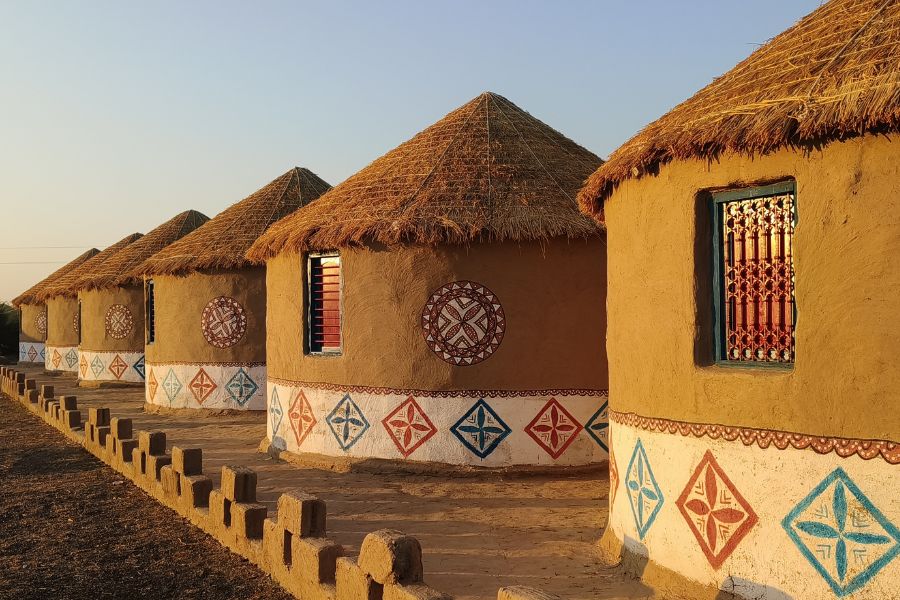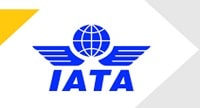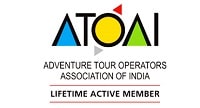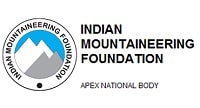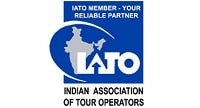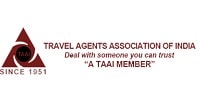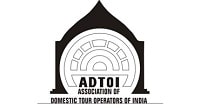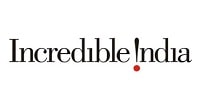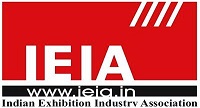Day 01 – By Air / By Train – Arrive Bhuj
Arrive Bhuj and transfer to your hotel. The historic city of Bhuj derives its name from the Bhujiyo Dungar, a hill, overlooking the present day Bhuj town. Bhuj is a typical example of a desert town located between two geographical features - Bhujiyo Dungar on the east & Hamirsar Lake on the west. Bhuj, the major town of Kutch, is an old city established in 1510. With its surrounding wall, the atmospheric bazaar area, crenelated gateways, old palaces, and striking temples the town still retains a medieval character. Every Nov/Feb it hosts the annual Rann Utsav festival. Overnight at hotel.
Day 02 – In Bhuj
After breakfast visit Ajrakhpur and Bhujodi. The artisans of Ajrakhpur specialize in Ajrakh – a Block Printed cotton cloth used traditionally by local herdsmen with natural dies. Its geometrical and nonfigurative motifs often mirror those appearing in Islamic – influenced Indian architecture.
Later stop at Bhujodi – a village skilled in traditional Bandhani (tie & dye), block printing and weaving. Here you can view live demonstrations and buy anything from shawls to blankets from the artisans directly. Bhujodi is also a centre for Piltoom weaving, Mewada Embroidery & Wood Carving. Nearby is the Hiralakshmi Crafts Park – a nonprofit undertaking by the Ashapura Group of Companies that works with artisans throughout Kutch to show their skills and retail their crafts.
Not far from Bhujodi is Shrujan, a non-profit working to complement rural women's income through the enhancement and marketing of their embroidery products. Shrujan has a store, design centre, manufacturing unit and an impressive collection of embroideries on site. One can also tour the campus which utilizes traditional and environmentally sensitive architecture. Types of Embroideries: Aahir Embroidery, Soof Embroidery, Chakan Embroidery, Jat Fakira Embroidery, Jat Garasiya Embroidery, Kambiro & Khudi Embroidery, Katri Embroidery, Kharek Embroidery, Mukko Embroidery, Neran Embroidery, Pakko Embroidery, Rabari Embroidery. Overnight at hotel
Meal: Breakfast
Day 03 – In Bhuj
Today after breakfast proceed for day excursion to Banni villages. (North Bhuj). Amidst the Desert land of infinite dimensions, are suspended, quaint little villages. These are the last villages on the India-Pakistan border. Here you will come across master craft people' exposing their traditional art, turning our master pieces every day. Their ornaments, clothes, utensils, everything they use - will make you feel as if you have stepped into lifestyle museum leaving you spellbound.
Nirona: The village of multiple talents! The village of Nirona is the only place in the world where the tradition of Rogan art is still practiced (a method of producing dyes from natural resources and castor oil and creating intricate and long-lasting designs on silk and cotton). Rogan art is a rare craft that is not well known even in India. Because of its rare qualities, it is practiced by only one family in India and they reside in Nirona village in Gujarat. They would be happy to teach you a trick or two in the intricate Rogan painting.
Nirona also offers the chance to see artisans making copper bells. The Luhars in Nirona have been preserving the craft of making copper bells over seven generations. The art form originally comes from Sindh and some sister villages in Pakistan too make similar bells but with carvings on the surface.
Another family in Nirona is practicing wood lacquering. Raw lacquer in various colours is passed with great skill on the wooden object of focus in beautiful waves. The work they do is mainly focused on household items like jewellery boxes and kitchen utensils and is known to last more than 30-35 years. If the lacquer work starts to lose its sheen, just apply some oil on it.
Visit the Bhirandiyara – is a favourite Tea stop for locals and visitors alike on the road to Khavda. The village boasts of a delicious sweet – fresh Maavo. This milk-based sweet is best when eaten hot. Most of the roadside stalls sell Maavo. The local Meghwal Community has exquisite embroideries and skillfully decorated, colorful Mud Bhungas.
Ludia Village is comprised of several hamlets belonging to the Meghwal & Samma Communities. The latter community, primarily herdsmen, is more conservative when it comes to tourists. Gandhi nu Gam, populated by the Meghwal community, features beautifully Painted Bhungas. The Kanjari (Blouses) of the women and the Bhunga decoration of this village are especially colorful.
Khavda' pottery is an art form of Khavda, North Kutch. While the men do all the throwing in terracotta, the women handle all the surface decoration which in this northern Kutch village of Ludia is primarily in the form of painting.
The potter gets mud from a specific acre (A lake) area near village. It is called 'Rann ka mitti'. This soft clay is shaped into a pot on a potter’s wheel and left to dry in shade, then Kumbhar women use red, black, and white clay-based paints to decorate each piece of pottery with distinct community-specific designs. After a while, it is cleaned and put in the sun to dry and then baked in a furnace, powered by simple and locally available fuels of dry wood and cow dung. The vessels are coated with a thin wash of geru (red color). The pots of Khavda get their red colour from Geru, a type of soil (ocher/ umber), and the black and white dots and stripes are also made with natural material. Finished pieces lie aside, ready for drying. The terracotta pots of Khavda are distinct from the ones we may see elsewhere, because of their painting and form which is a result of repeated cleaning at every stage of the process of their making.
White Rann : the spectacular sight of boundless white desert is the stunning creation of nature, unique to this world. Overnight at hotel
Meal: Breakfast
Day 04 – In Bhuj – By Road – 65 Kms / 01 Hr – Bhuj To Mandvi (One Way)
After breakfast proceed for day excursion to Mandvi. Visit Kala Raksha Trust, a grassroots social enterprise, is dedicated to preservation of traditional arts. Envision this broadly, as holistic encouraging of the creative capacity of the artist. Comprising artisans, community members, and experts in the fields of art, design and museums, Kala Raksha was founded on artisan initiative in 1993 in the desert region Kutch, in India. Uniquely committed to documenting existing traditions, the Trust maintains a collection of heirloom textiles housed as a local Museum. Artisans participated in establishing this Museum. Thus, it embodies a simple but revolutionary concept: involve people in presenting their own cultures. Kala Raksha Centre is in Sumrasar Sheikh, 25 km north of Bhuj. Later continue to drive to Mandvi.
Mandvi is located on the banks of the Rukmavati River, barely one km from the Arabian Sea at the Gulf of Kutch. The town has a very pleasant climate throughout the year, and it was a summer retreat of the Kutch Maharaos. The centre of attraction at Mandvi is the Vijay Vilas Palace, a royal abode set in the middle of well-laid gardens with water channels and marble fountains. The architect and craftsmen from Jaipur designed and constructed the palace in 1920 AD. The palace has all the elements of Rajput architecture and draws largely on the plan of palaces of Orchha and Datia. The central high dome on the pillars, the Bengal domes on sides, the windows with colored glass, carved stone Jaalis, domed bastions at the corners, extended porch, and other exquisitely stone carved elements, make the palace worth visiting. It owns a private beach, maintained in an eco-friendly manner to preserve its pristine beauty. It is an example of the traditional skill of craftsmen of early 20th century.
Visit Ship building yard. On the banks of the Rukmavati River, just south of the bridge, you can visit the still-active shipbuilding yard. Craftsmen still assemble ships out of wood, for local or international guests, and you can feel free to watch them work. It gives us an opportunity to watch handmade ship being built which will make one truly appreciate craftsmanship. The process is long and elaborate and shoddy workmanship means risking sailors' lives. Later drive back to Bhuj. Overnight at hotel
Meal: Breakfast
Day 05 – By Air / Train – Depart Bhuj
After breakfast visit the Kutch Museum, formerly known as the Fergusson Museum. The Kutch Museum is the oldest museum in Gujarat. This museum is built in the Italian style and located in picturesque surroundings on the banks of the Hamirsar Lake. The museum has a large collection of Kshatrapa inscriptions, various archaeological objects, arms and specimens of various crafts of the Kutch region.
The Cenotaphs Complex or Chattardi was built of red stones. These tombs were ruined by the successive earthquakes since 1819.
Kera is mainly known due to the 10th century old temple of Lord Shiva.
Prag Mahal was constructed by Rao Pragmalji II who appointed a famous architect, Colonel Henry Saint Wilkins to design Prag Mahal, who had earlier designed Deccan College, Sasoon Hospital, Ohel David Synagogue. Prag Mahal took about 10 years to get built at the cost of 20 lakh rupees.
Aaina Mahal Palace was built by Rao Lakhpatji in 1750 AD. Aaina Mahal is a part of a large palace complex. It is a two Storey building with Darbar Hall, hall of mirrors, and suites for royal family. In the 18th century, the Rao Lakhpatji sent a local craftsman Ramsingh Malam to Europe to perfect his skills in glassmaking, enamelling, tile making and iron founding. After he returned, he constructed the Aaina Mahal with the hall of mirrors of Venetian glass.
Later in time transfer to Bhuj Airport / Railway Station to board flight / train for your onward journey to your next destination.
